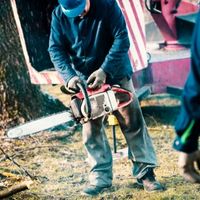Ryobi chainsaw not starting. The Ryobi chainsaw won’t start. The spark plug may be defective. To determine if the spark plug is defective, remove the spark plug and inspect it.
If the spark plug appears fine, then you likely have a clogged carburetor, usually caused by leaving fuel in for the chainsaw for too long. Here are other reasons why that might happen and how to solve them:
Ryobi chainsaw not starting
Ryobi chainsaw won’t start. The reason might be that to determine the problem if the spark plug is defective, remove the spark plug and inspect it. If the spark plug is defective, you will need to change the spark plug.
Defective Spark Plug
The spark plugs can be faulty if you fail to check them and replace them at the start of every season.
Inspecting the sparks is easy, and it’s a much better option than looking for another issue with your engine later on.
If the electrodes are damaged, have signs of cracks or carbon deposits, or if your plug has never been changed, we recommend you change them immediately so that your chainsaw can have a longer lifespan.
Clogged Carburetor
Carburetor problems are often caused by leaving fuel in the chainsaw for a long period of time.
Over time, some of the ingredients in the fuel will evaporate, leaving behind a thicker, stickier substance.
This sticky fuel can clog up the carburetor and prevent the engine from starting.
While you may be able to clean out your carburetor with a spray cleaner, if this isn’t effective, it’s best to work with a professional to rebuild or replace it entirely.
The recoil starter assembly is not working properly
A recoil starter assembly engages the crankshaft to turn over the engine. If your chainsaw is not turning over and you believe that it’s due to a fault, there is a possibility this might be the issue at hand.
To troubleshoot any such problem, one should first consider checking the function of their recoil starter assembly to see if it’s functioning properly because if this part is ill-functioning or, worse damaged, then the chainsaw won’t begin.
The test that should be conducted on this part would be a simple “pull and release” action which will determine whether or not it’s working correctly so that any necessary replacement can take place accordingly.
The recoil starter pulley is damaged
The recoil starter pulley of the engine controls the release and retraction of its starter rope. If the engine’s recoil starter pulley is broken or stuck, it won’t release or retract its rope.
As a result, the engine will not turn when you try to start it because there isn’t a starting tug available. If your engine’s recoil starter pulley is broken or damaged, replace it with a new one before you attempt to start your engine again in order to ensure that you don’t risk mechanical failure while operating the device.
Broken Rewind Spring
Some chainsaws will have a rewind spring. The recoil starter is used to help pull the piston back into the case in order to start the engine.
The spring may be stretched out over time or otherwise damaged and cause problems with starting the chainsaw. Replacing it can solve this problem.
Ignition Coil Issue
Ignition coils send voltage to spark plugs as part of the chainsaw ignition system. If one malfunctions, the entire system is affected, and starting or running a chainsaw will be nigh impossible.
Still, even if the ignition coil has failed and you can’t start your chainsaw, there may not be any need to panic.
Sometimes it’s actually a spark plug, not an ignition coil, that fails. Before you replace your faulty ignition coil, make sure that all of your spark plugs are in working order by testing them yourself with a spark plug test tester.
If any of your spark plugs fail the test, replace them before replacing the faulty ignition coil.
Related Guides
